Volleyball Passing Techniques – Various Passing Forms
Read about various volleyball passing techniques. We should try to pass the ball in front of our hips, have a well balanced position and our both feet on the ground, right? However, knowing only this “standard” passing form isn’t enough. There are other passing techniques we should learn about.
Volleyball Passing Techniques
Basic Stance – Volleyball Stance
Place your feet a little bit wider than your shoulders. Drop your hips closer to the ground by bending your knees. Shift your weight on the ball of your feet - if the weight is totally on the heels you may find it difficult to move quickly.
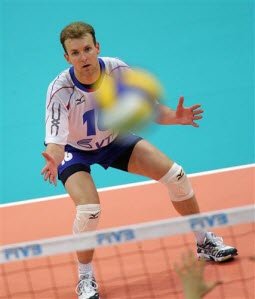 Volleyball
Passing Stance - Arms Unattached
Volleyball
Passing Stance - Arms Unattached
When preparing to pass (or to play defense) keep your arms
unattached.
Keep your arms bent in around 90-145 degree angle.
Place
your
arms/hands somewhere “half way” - between bumping and setting position.
Then you are able react quickly and either pass the ball with fingers
overhead
or bump it with forearms. Do not tie your arms together to
bump
the ball because you may have to pass by overhead setting.
High Volleyball Passing Position
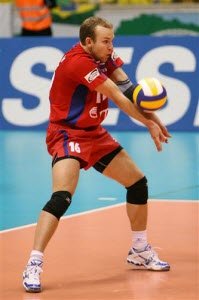 Volleyball Passing - High Position
Volleyball Passing - High Position
You will most likely use this technique to pass floaters, since you have to pass the ball, which flies horizontally.
When the ball floats, it travels high "straight forward" and usually doesn't "pull down" as rapidly as a top spin serve. So when the ball travels "straight forward" you have to “move in front of the ball”, most likely you can’t get “under the floater”.
Low Volleyball Passing Position
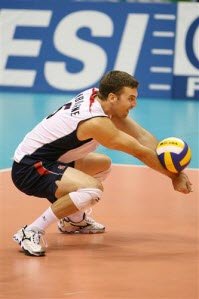 Volleyball Serve Receive Low Position
Volleyball Serve Receive Low Position
You may use this technique to pass top spin serves, like jump serves.
The top spin pulls down the ball rapidly therefore the serve receiver needs to get very much “under the ball” to be able to pass it.
Arm/Hand Position – Platform Angle in Volleyball Passing Techniques
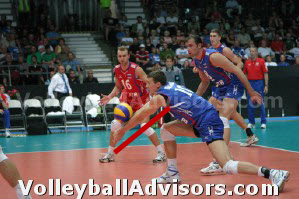 Volleyball
Passing Form - Platform Toward the Setter
Volleyball
Passing Form - Platform Toward the Setter
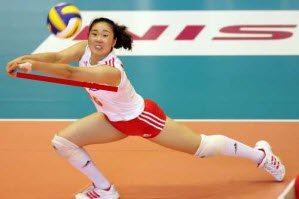 Volleyball
Passing Form - Platform Toward the Roof
Volleyball
Passing Form - Platform Toward the Roof
When passing receiving a top spin serve or a very short serve, notice the arms may be placed "parallel to the ground level" - your platform may point "toward the sealing" since you have to get "under the ball" and pass the ball "up". (Look at the 2nd picture on the right).
If receiving floaters or serves near the back line your platform may point toward the setter (fingers and arms may point toward the ground) and you try to pass with a very small arch - you can almost "shoot" the ball. (Look at the 1st picture on the right.)
Compare the pictures and you get the idea how the arm platform angle changes.
Notice also how in the other picture the ball is not passed in front of the hips, but on the side.
Volleyball Passing Techniques - How to Pass When the Ball is
Outside the Perfect Passing Range?
Passing the ball on the side of the body
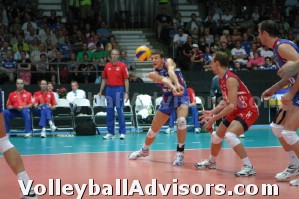 Volleyball
Serve Receive on the Side
Volleyball
Serve Receive on the Side
In modern volleyball serves have become so powerful that players simply don’t have enough time to move under the ball. It is crucial to learn to pass the ball all around the body.
Passing the Ball High on the Side
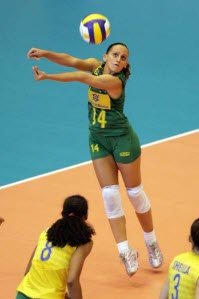 Volleyball
Serve Receive - High Receive on the Side
Volleyball
Serve Receive - High Receive on the Side
When passing a high ball on the side the player turns toward the sideline.
The player may need to take a step backwards with the right foot when turning to the right – or with the left foot when turning to the left.
Three point passing technique – Knee on the ground
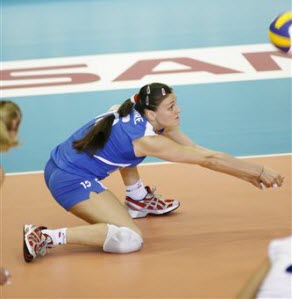 3
Point Serve Receive - Knee on the Ground
3
Point Serve Receive - Knee on the Ground
In order to get under the ball a player may need to drop the hips very close to the ground and place the knee on the ground.
On the left side the player may drop the right knee on the ground - and on the right side the left one.
Overhead passing
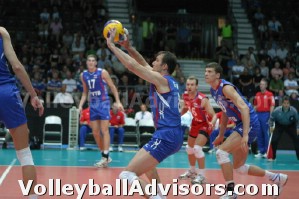 Volleyball
Overhead Serve Receive
Volleyball
Overhead Serve Receive
Try to contact the ball in front of your face or above your forehead. The technique is slightly different than in setting.
You fingers and upper body need to be “more flexed” when compared to setting. You need to use "more strength" in overhead serve receive vs. setting, so the ball doesn't come through your hands. The touch is not so soft, but kind of rough.
How to practice these volleyball passing techniques?
When teaching these volleyball passing techniques to players it is important to practice them one at the time and pay lots of attention to each technique. Otherwise players use only techniques they are the most comfortable with and never learn to use different techniques in the match.Like this page:




